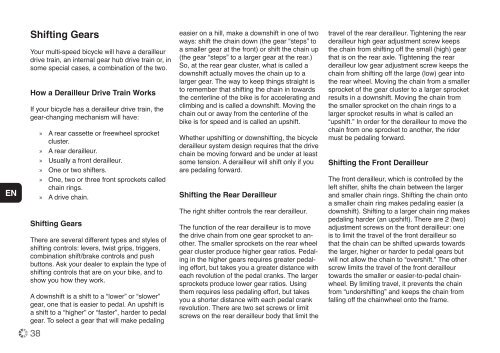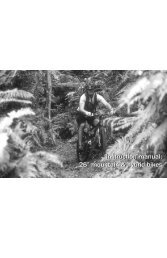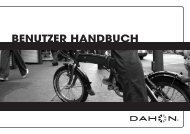BRUKERVEILEDNING - Dahon
BRUKERVEILEDNING - Dahon
BRUKERVEILEDNING - Dahon
Create successful ePaper yourself
Turn your PDF publications into a flip-book with our unique Google optimized e-Paper software.
EN<br />
Shifting Gears<br />
Your multi-speed bicycle will have a derailleur<br />
drive train, an internal gear hub drive train or, in<br />
some special cases, a combination of the two.<br />
How a Derailleur Drive Train Works<br />
If your bicycle has a derailleur drive train, the<br />
gear-changing mechanism will have:<br />
38<br />
» A rear cassette or freewheel sprocket<br />
cluster.<br />
» A rear derailleur.<br />
» Usually a front derailleur.<br />
» One or two shifters.<br />
» One, two or three front sprockets called<br />
chain rings.<br />
» A drive chain.<br />
Shifting Gears<br />
There are several different types and styles of<br />
shifting controls: levers, twist grips, triggers,<br />
combination shift/brake controls and push<br />
buttons. Ask your dealer to explain the type of<br />
shifting controls that are on your bike, and to<br />
show you how they work.<br />
A downshift is a shift to a “lower” or “slower”<br />
gear, one that is easier to pedal. An upshift is<br />
a shift to a “higher” or “faster”, harder to pedal<br />
gear. To select a gear that will make pedaling<br />
easier on a hill, make a downshift in one of two<br />
ways: shift the chain down (the gear “steps” to<br />
a smaller gear at the front) or shift the chain up<br />
(the gear “steps” to a larger gear at the rear.)<br />
So, at the rear gear cluster, what is called a<br />
downshift actually moves the chain up to a<br />
larger gear. The way to keep things straight is<br />
to remember that shifting the chain in towards<br />
the centerline of the bike is for accelerating and<br />
climbing and is called a downshift. Moving the<br />
chain out or away from the centerline of the<br />
bike is for speed and is called an upshift.<br />
Whether upshifting or downshifting, the bicycle<br />
derailleur system design requires that the drive<br />
chain be moving forward and be under at least<br />
some tension. A derailleur will shift only if you<br />
are pedaling forward.<br />
Shifting the Rear Derailleur<br />
The right shifter controls the rear derailleur.<br />
The function of the rear derailleur is to move<br />
the drive chain from one gear sprocket to another.<br />
The smaller sprockets on the rear wheel<br />
gear cluster produce higher gear ratios. Pedaling<br />
in the higher gears requires greater pedaling<br />
effort, but takes you a greater distance with<br />
each revolution of the pedal cranks. The larger<br />
sprockets produce lower gear ratios. Using<br />
them requires less pedaling effort, but takes<br />
you a shorter distance with each pedal crank<br />
revolution. There are two set screws or limit<br />
screws on the rear derailleur body that limit the<br />
travel of the rear derailleur. Tightening the rear<br />
derailleur high gear adjustment screw keeps<br />
the chain from shifting off the small (high) gear<br />
that is on the rear axle. Tightening the rear<br />
derailleur low gear adjustment screw keeps the<br />
chain from shifting off the large (low) gear into<br />
the rear wheel. Moving the chain from a smaller<br />
sprocket of the gear cluster to a larger sprocket<br />
results in a downshift. Moving the chain from<br />
the smaller sprocket on the chain rings to a<br />
larger sprocket results in what is called an<br />
“upshift.” In order for the derailleur to move the<br />
chain from one sprocket to another, the rider<br />
must be pedaling forward.<br />
Shifting the Front Derailleur<br />
The front derailleur, which is controlled by the<br />
left shifter, shifts the chain between the larger<br />
and smaller chain rings. Shifting the chain onto<br />
a smaller chain ring makes pedaling easier (a<br />
downshift). Shifting to a larger chain ring makes<br />
pedaling harder (an upshift). There are 2 (two)<br />
adjustment screws on the front derailleur: one<br />
is to limit the travel of the front derailleur so<br />
that the chain can be shifted upwards towards<br />
the larger, higher or harder to pedal gears but<br />
will not allow the chain to “overshift.” The other<br />
screw limits the travel of the front derailleur<br />
towards the smaller or easier-to-pedal chainwheel.<br />
By limiting travel, it prevents the chain<br />
from “undershifting” and keeps the chain from<br />
falling off the chainwheel onto the frame.





